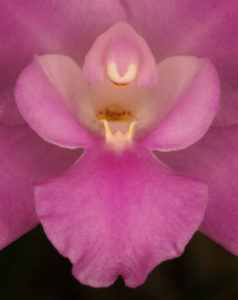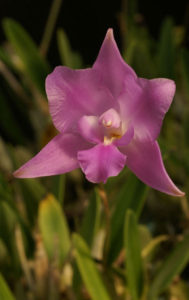The following article was written for the Orchid Species Bulletin published by the Orchid Species Society, which is based in Brisbane, Queensland in September 2009.
Bear in mind that any cultivation notes refer to the subtropical conditions of Southern Queensland, Australia.
 Laelia furfuracea Lindl. was described by John Lindley in the Botanical Register in 1839. He gave it the specific epithet from the Latin furfuraceus (scurfy) for the tiny dark brown or blackish scales that cover the ovary and flower stem. It was discovered by Count Karwinsky around 1832 and introduced to cultivation in England in 1838 by Mr. Barker of Birmingham.
Laelia furfuracea Lindl. was described by John Lindley in the Botanical Register in 1839. He gave it the specific epithet from the Latin furfuraceus (scurfy) for the tiny dark brown or blackish scales that cover the ovary and flower stem. It was discovered by Count Karwinsky around 1832 and introduced to cultivation in England in 1838 by Mr. Barker of Birmingham.
L. furfuracea has been placed in the section Podolaelia, which is found in Central America, together with L. albida Lindl., L. anceps Lindl., L. aurea Navarro, L. autumnalis (La Llave & Lex.) Lindl., L. bancalarii Gonzalez, Tomayo & Hagsater, L. gouldiana Rchb.f. and L. rubescens Lindl.

L. furfuracea is found at high altitudes in the mountains of Oaxaca, southern Mexico, growing on the rough bark of scrubby oak trees at 2,100-3,000m elevation.
It is a small plant with clustered oblong-ovoid to pear-shaped pseudobulbs that are 3-5 cm high and are longitudinally wrinkled when old. At the apex of each pseudobulb is a single straight, stiff leathery, lanceolate pointed leaf that is 5-12 cm long.
L. furfuracea bears 1-3 flowers that are 7-9 cm across. The flowers are borne on a short flower stem, which is about 25-35 cm long and is short compared to other members of the section Podolaelia. The flowers have rose to rose-pink sepals, petals and the lip is of similar colour or with a darker mid-lobe and two cream to white keels or ridges on the disc. Its broad diamond-shaped petals are recurved at the tips. The column is pale rose. Other colour forms of L. furfuracea include deep rose-purple as well as very pale blush pink and pure white. The pleasantly scented flowers are produced in late winter and last for about 3 weeks.
Its closest relative is L. autumnalis, which has a larger plant habit with longer racemes carrying more flowers (usually 5-6 and up to 13-15) that have a yellow, 3-ridged callus.
L. furfuracea seems to grow and flower well in the southeast Queensland area. Any well-drained potting medium suits it well. Strong light of 50-70% shading, together with plenty of water, fertiliser and good air circulation will ensure good growth during the growing phase. In keeping with its natural habitat a cooler, drier rest after flowering is required, with just enough moisture to prevent the pseudobulbs from shrivelling excessively. This dormancy together with good humidity ensures that the roots will remain in good condition.
